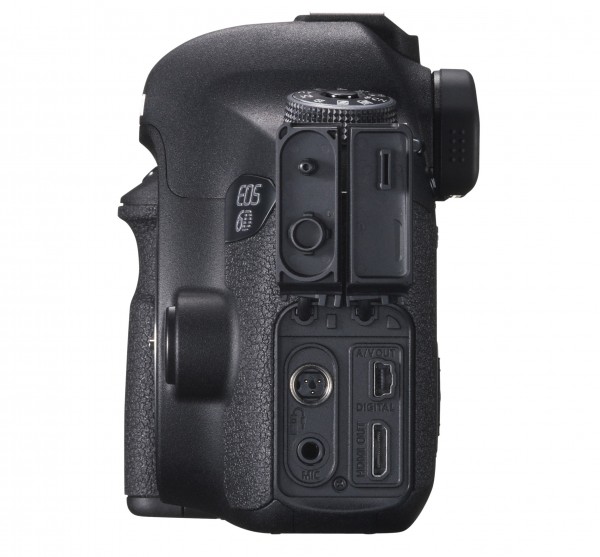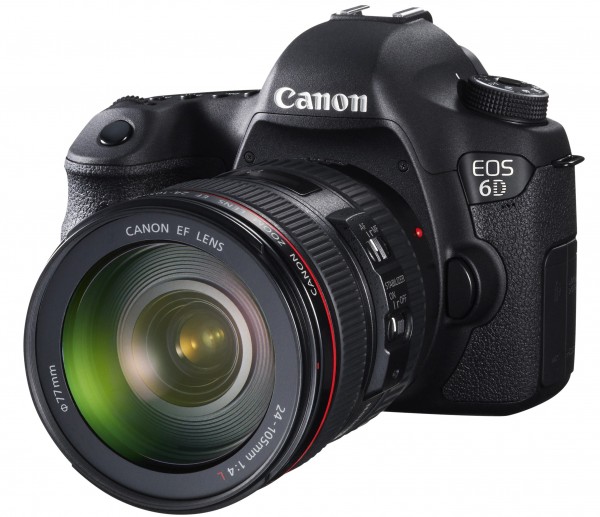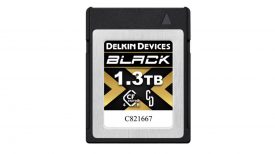By site editor Dan Chung:
A first glance the Canon EOS 6D looks like a great options for real world video shooters searching for a large sensor on a limited budget. It’s video specifications are similar to its rivals – the newly launched Nikon D600 and Sony A99. In fact in many ways it is a more attractive than it’s older sibling – the 5D mkIII. It offers the same resolutions and frame rates but adds Wi-Fi and GPS into a smaller, cheaper body.
But there is one small problem – Canon have unwisely omitted an all important headphone jack from the 6D. Without it there is no way to monitor what you are actually recording in the camera – the same as older cameras like the 5D mkII, 7D and 60D. By contrast the Nikon D600, D800, Sony A99 and Canon 5D mkIII all have a headphone jack.
There are of course work arounds that many of us have been using for years with the original 5D mkII, like external audio boxes or dual system sound, but in 2012 this should be completely unnecessary. The lack of headphone monitoring is a good enough reason for news and documentary shooters not to buy the 6D as their primary camera.

Canon have presumably omitted the headphone jack on the 6D to save cost, or to differentiate it from the 5D mkIII in their product line. I years gone by I might have accepted that there wasn’t the space in the camera body for the headphone jack, but not after the launch of the smaller, cheaper Panasonic GH3 with a 3.5mm jack onboard.
There are of course plenty of users for the camera that are unaffected by the lack of headphone monitoring. If you only shoot music videos or need a cheap full-frame 2nd body for multi-cam work then it might be worth a look. I’m sure it is a fine stills camera too and good for the photographer who only occasionally dabbles in video.
One thing that will be of interest is the image quality of the 6D. If it is sharp and moire free, like the flagship EOS-1D X and 1D C (at 1080P), then narrative shooters should be delighted. For them the camera may be a good option.
The hardcore multi-media journalist in search of a full-frame DSLR would be better off with a 5D mkIII, Nikon D800, D600 or maybe the Sony A99 or NEX-VG900. Of course there is the separate question of whether you actually need a full-frame video camera at all – but that’s another story altogether.
Here are the details from Canon PR:
Enter the full-frame world: Canon unveils its smallest and lightest full-frame DSLR – the EOS 6D
United Kingdom, Republic of Ireland, 17 September 2012 – Canon today unveils its latest EOS DSLR for serious photography enthusiasts – the EOS 6D. A similar size and weight to the EOS 60D, the EOS 6D is the world’s lightest[1] DSLR to feature a full-frame CMOS sensor, making it ideal for travel, portrait and landscape photographers. The model creates a new entry point into Canon’s full-frame line-up, and is perfect for those who want greater control over depth of field, or to maximise the impact of shooting with the EOS system’s extensive range of wide-angle EF lenses.
Benefiting
The EOS 6D combines a powerful, full-frame imaging system and superior low-light performance with a compact, robust and lightweight design. For the first time in any EOS model, Wi-Fi[2] and GPS[3] connectivity are included, empowering photographers to capture stunning images on the move, tag them with location information and wirelessly transfer them to a computer, the cloud, or smartphones.
Incredible images in all conditions
Benefiting from 25 years of EOS innovation, the EOS 6D features a newly-designed 20.2 Megapixel full-frame CMOS sensor that allows photographers to produce poster-sized prints, or to crop into their shots with no compromise in quality. A native ISO range of ISO 100-25,600 (extendable to 50-102,400) also makes capturing crisp, natural shots in near darkness easier than ever before.
A new 11-point AF system also offers the strongest low light performance of any Canon AF system to date. With focusing down to EV-3, the equivalent of moonlight, subjects remain in-focus in even the most challenging lighting conditions – offering the freedom to shoot landscapes or portraits at night and capture the true atmosphere of the scene with minimal noise.
Explore your creativity to the full
The inclusion of a full-frame sensor offers greater control over depth of field in portraits, allowing photographers to easily isolate their subjects with attractive background blur. With the EOS 6D, photographers can now also explore the full potential of their wide-angle EF lenses to capture every detail of a sweeping landscape, with models ranging from 8mm to 800mm. Additionally powerful DIGIC 5+ image processing offers a host of automatic modes and creative shooting features, complementing full manual controls to offer total flexibility to a wide range of users.
The EOS 6D is full of advanced features to assist photographers in capturing outstanding quality landscapes and portraits. HDR mode enables the capture of both highlights and low lights in tricky lighting conditions, while Multiple Exposures allows photographers to combine up to nine separate exposures into a single image in-camera, creating a dramatic effect in the final picture. A silent drive mode offers a more subtle option for shooting candid portraits or weddings, and a single axis electronic level accessed through the viewfinder or via the LCD screen, ensures that horizons are level during image composition.
Built for sharing
The first ever EOS to feature integrated Wi-Fi connectivity, the EOS 6D enables photographers to share their work immediately after shooting. Images can be wirelessly transferred to external storage devices, uploaded to Facebook and YouTube, or printed wirelessly using a Canon Wi-Fi enabled printer. Alternatively, movies and images can be viewed on DLNA-enabled HDTVs – enabling high-quality, big-screen viewing. By wirelessly connecting to a smartphone, photographers can also remotely control the camera, adjusting shooting settings and focus before remotely triggering the shutter and viewing the captured image.
Using the EOS 6D’s integrated GPS, images can be tagged with location data as they are shot. Travellers can also build a more complete record of their trip by using the GPS logger function to track their route, which can be displayed using the supplied Map Utility software
Robust, intuitive design
Measuring just 144.5 x 110.5 x 71.2mm and weighing 770g[4], the EOS 6D is the most compact full-frame EOS DSLR ever manufactured. Its dust and drip-proof, part-magnesium body offers robust protection and an intuitive button layout for easy control. Photographers can also view their shots in stunning detail and with natural colours on the large, high-resolution 7.7cm (3.0”) Clear View LCD screen, which features an enhanced anti-glare design to permit viewing in bright sunlight and at extreme angles.
A new Battery Grip BG-E13 provides additional power for extended shooting, while also making it easy to shoot both vertically and horizontally. When used with two LP-E6 batteries, the battery grip offers double the number of shots, and it can also be used with AA batteries for added convenience and flexibility.
EOS 6D – key features
Full-frame 20.2 Megapixel sensor
Tough, lightweight construction
Max ISO 25,600 (expandable to ISO 102,400)
11-point AF sensitive down to -3EV
GPS[3] records your location
Wi-Fi[2] file transfer and remote control
Full-HD video







